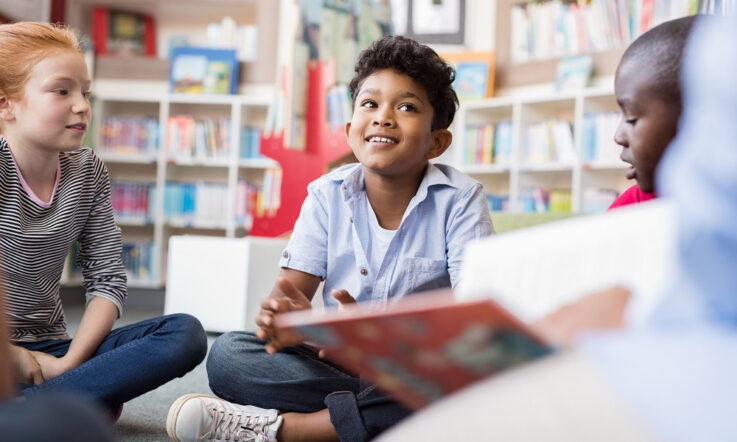Thanks for downloading this podcast from Teacher magazine. I’m Dominique Russell.
A literature review undertaken by Hannah Yared from Monash University has examined racism and racial bias in the Australian primary school context.
In total, six studies were examined for this research which uncovered four main themes. The first is a lack of teacher confidence and competency regarding racial issues. This meant that in general, teachers tend not be have the confidence to engage fully with racially diverse students, and to discuss racial issues in a meaningful way. The second theme was white normativity, which is in reference to the fact educators tend to position whiteness as the norm for which everything is compared to.
Third was colour-blindness which in this instance refers to the belief that minimising discussions about racial differences or racism is actually better than drawing attention to them, which Hannah’s research found many teachers tend to believe. And the final theme was silencing, which refers to the silencing of discussions about racial issues.
Crucially though, Hannah’s research uncovered some important points on how school communities can best tackle this issue; the role of school leaders in supporting teachers address their behaviour; and how teachers themselves can address their own biases. There’s a lot to cover in this episode, so let’s jump straight in by hearing a little bit from Hannah on her career in educational research so far.
Hannah Yared: So my main role at the moment at Monash is as a PhD candidate (a PhD student) and my research for that is in I guess, it sort of bridges the gap between psychology and education. So it’s exploring children and young people’s understanding and experiences of race and racism with a focus on school settings. So it examines primary and secondary school student’s racial literacy, their levels of racism, attitudes towards race and their experiences of racism and how that, I guess, ties into their racial identity and their sense of school belonging. And so that’s, the paper that was sort of recently published was one phase in that sort of broader research project.
And I also teach across inclusive education, psychology and counselling. And I’ve been involved in a couple of the inclusive education and psychology projects as well. And I help in assisting to implement and evaluate a social-emotional learning and a group wellbeing program that Monash delivers in schools as well. And then when I’m not doing all of that, I also work and do psychology work with kids as well. So there are lots of things going on!
Dominique Russell: Certainly, fantastic. So this paper that was recently published that we’re going to be talking about today – I’m interested why this research important for you to conduct and why was it important in particular to focus on the primary school setting?
HY: Yeah, so the overall project’s looking at primary and secondary settings but this particular paper was focusing only at primary schools. And that was because it became really apparent when I was looking at the literature that there wasn’t much research out there in Australia. And the research we did have tended to focus on secondary schools. And a lot of the research we’re relying on comes from overseas and while that’s been really instrumental in our understanding of racism in schools, there are really important cultural and historical and contextual differences between, for example, Australia and the US, where a lot of the research comes from and that really needed to be accounted for in research.
I guess the second, or the other reason why I wanted to explore primary schools was because children are entering primary school during a really crucial time in their social-cognitive development and it’s a time where they’re learning about the world and their place within it and they’re also developing a strong sense of morality and justice, but they’re also developing prejudice at the same time.
And given schools are, I guess, really strong, racial, ethnic socialisation spaces – so that sort of means that it’s a space where children learn positive and negative messages about race – given those two things are occurring; you know children’s development and schools’ impact on this development it was kind of really important to understand how we can use schools as an early intervention tool, I guess, to steer kids towards those more pro-social views and away from bias and racism before it becomes ingrained later on in life.
DR: Absolutely. And so in your report, I noticed that you write ‘In order to understand racial issues in education, an understanding of the interconnectedness between race, ethnicity and culture is necessary.’ So can you summarise this interconnectedness, and share why this understanding is so crucial particularly for classroom teachers?
HY: Yeah this is so important. Like, I guess in short, culture is something that we learn from our environment and it contributes to a collective mindset that differentiates one group of people from another. Ethnicity has biological markers, whereas race is a socially constructed category and doesn’t have a biological base. Although people can still be impacted – and students as well – by associated issues, such as racism, even if race is a social construct.
And what I found when I was reading a lot of the research and talking to people, you know, it became really apparent that not everybody understands those terms and people often use them incorrectly or sort of use them sometimes interchangeably when discussing discrimination.
For example, a lot of studies, a lot of education research that was sort of claiming to be talking about racism, when I really looked at it and pulled it apart it appeared as though they were actually talking about different forms of discrimination like cultural, based on religion or things like that. Which were all obviously still very important areas to look into, but this idea that all of these things are interlinked inherently is a fairly biased assumption.
And look, it’s absolutely true that for a lot of people their race, and their culture, their ethnicity and language and all those things sort of tie in, but for example, I guess, if you take a white Anglo-born Australian and somebody else who’s also born in Australia but perhaps their background is Ethiopian or Eritrean or Somali and they all grow up and are born in Australia, those two people might potentially share a nationality or a culture and all of these things, but they’ve got different races and different ethnicities. So lumping it all together and assuming that it’s all the same misses those really important nuances.
And this has led people to have this tendency to assume that racially marginalised groups are really strongly influenced all the time by cultural factors. Whereas white individuals are shaped predominantly by psychological factors, like personality, and that can really play out in a classroom when – for example, often you’ll hear things like teachers or sometimes other parents if they think a child’s acting up or acting in a challenging way, they might say, ‘oh, it’s because of their culture’. Whereas with other students it might be, ‘oh, it’s their personality’.
And so some students are afforded an individuality, I guess, that other students aren’t. And there are also really – the other thing that’s quite important in that space is also that there are some potential (and the research is still sort of emerging here) developmental differences in how those biases are expressed, especially when considering that race and ethnicity are more visible than other forms, you know, other parts of people’s identity, like religion (to an extent) or culture and things like that.
And kids, it’s possible that they rely on things like visual cues in terms of their biases and that kind of stuff. So I guess that sort of hopefully sums it up in a somewhat simplified way.
DR: Absolutely. And can you describe what your research has shown about where the teaching environment stands now in terms of racism and racial bias? And what are the implications for this, would you say, in terms of particularly school culture, but then also student welfare and learning?
HY: Yeah absolutely so at the moment there appears to be a real mismatch and this is what the paper that I published sort of revealed, that there was a real mismatch between what children need and what they want in terms of conversations around race or dealing with racism and what schools and teachers are actually providing them with.
So teachers appear to I guess avoid or minimise a lot of these discussions which sometimes is driven by an incorrect belief that children don’t see race, they don’t see colour, or they’re too young to have these conversations. And you know, whereas the research shows kind of the opposite – that children do see race, they’re capable of holding racially biased views and acting in racist ways.
And that might sound really concerning, but they’re also capable and very much in need of educative conversations to build in that sense of morality and strong sense of justice. And avoiding these conversations can potentially increase children’s biases. Because when we stop talking to kids about race, they don’t stop thinking about it.
And so we just merely, I guess, instil this idea that some of these topics are out of bound or they’re taboo or there’s something wrong or discussing race is inherently racist and it means that these negative views might develop and then go on unchecked into adulthood.
And because children are entering school during a really crucial time in their social-cognitive development – and that’s where that sense of morality (like I discussed before) and their sense of justice is developing alongside that prejudice.
You know, schools and teachers can really either help children navigate that space by engaging in those conversations or they can really stifle that crucial development. And the other thing as well to consider is that students need, I guess, to process these issues in order to have the critical thinking and problem solving skills necessary for life after school.
And it’s also really important to know that avoiding those conversations really doesn’t give marginalised children who experience racism that space to really process that trauma that might develop from that. So it actually is really doing a disservice to all kids when we sort of take that approach of avoidance, I guess.
DR: And so perhaps that discussion just there can kind of lead into the four key themes that really emerged from this section of the study and the data analysis that you conducted. So, what were those four themes and did any of them surprise you at all?
HY: Yeah so the four themes that came out were a lack of teacher competence and confidence in sort of dealing and discussing racial issues in the classroom; white normative teaching practices; colour evasiveness and sort of silencing as well was the fourth theme (silencing of racial issues or racism).
And when we consider, I guess, the international research and what that tells us, the results aren’t particularly surprising to researchers. But I think, I guess, when we sort of get into the nuts and bolts of what all of those things mean it might be a little bit surprising for teachers and school leaders.
And I guess part of that as well is just thinking – another thing that sort of came out from it was the difference between the diversity of the students and how that’s rapidly increasing, whereas the diversity of the staff has stayed relatively the same. And so there’s not that perhaps same understanding and experience from a teacher perspective and that’s maybe why it might be a little bit surprising.
DR: And so in the report, something else that I took notice of was it showed that it’s very clear that the research has identified that teachers need support in understanding racism and racial bias within a school context – as you say, the competence and confidence of teachers was a theme that emerged – but at the same time, researchers don’t know how to best give this support.
So I’m interested if your research shed any light on anything that’s important to keep in mind when thinking about offering this kind of support on this issue for teachers? Or I guess in other words, what school leaders should keep in mind is this is something they want to address in their school community?
HY: Definitely. I think the one really great thing as well that came out was that even though teachers didn’t feel competent or they didn’t feel like – you know, a lot of their pre-service and in-service training doesn’t really account for racial diversity. Another thing they said was they were really wanting that training, they really did want to engage with it, they did want to know how to support their students.
But a lot of teachers didn’t know, don’t always feel supported by school leaders to navigate that space, so I think that really highlights the importance of having school leaders who support the ethos of inclusion and anti-racist teaching practices and who are capable of guiding their team of teachers and students through those processes.
And these things, they really do need to filter down from above to teachers. And teachers need to feel as though this is something that’s really important to the school leaders and it’s kind of a non-negotiable that their school is going to engage in those things. And this includes leaders developing really clear anti-racism policies in their schools to assist in doing that effectively, to actually have a clear outline for teachers. And that especially relates to things like racist bullying, where it’s often dealt with in the same way as regular bullying and doesn’t account for that additional layer of discrimination based on skin colour and race.
And also making sure that teaching materials and things like that – whether it’s books or texts or pictures around the classroom – making sure that all of those things are culturally responsive and reflect the diversity of students as well. So it really definitely needs to filter down from above.
DR: Something that you’ve also mentioned in your study was that perhaps increasing teacher self-awareness of their own biases and worldviews may contribute to increasing this confidence issue that they have in discussing these areas with children in their classrooms. So for educators listening to this podcast, how can they really go about assessing their own biases and worldviews?
HY: Yeah that’s a really good one. I think one thing to remember, I guess, for teachers to take on board, is that understanding that racism doesn’t magically vanish when we enter the school gates. And teachers are just as likely to hold racist views and biased views as anybody else in society.
And there are ways that you can go about looking into the different types of bias. There are – you know, Project Implicit has tests that you can do to see if, you know, what’s sort of perhaps lurking below the surface is more biased than you would believe.
But I think one thing is perhaps even just redefining completely how we even look at, or how we view racism. Because oftentimes people, if you say to somebody that they might be racist or they might be biased, it automatically brings up a defensiveness. You know, nobody wants to be considered to have those views. And I think that stems a lot from this binary view that we have that you’re either a bad person who’s racist or you’re a good person who’s not.
And there’s no room to really move when we think about it like that because nobody wants to consider themselves to be a bad person. But it’s actually entirely possible to be both a good person and to also have racist views as well. And to understand that, that doesn’t actually make you a terrible person. It’s kind of almost impossible to live in this world without soaking up some of that stuff. And it’s about perhaps reframing it and sort of thinking about how that might impact you and your teaching and perhaps even having other people observe you and have a look to see, you know, are you treating kids differently based on certain assumptions that you have about their culture or their race or things like that.
And just also I guess getting comfortable with those uncomfortable discussions and exploring those uncomfortable spaces because it isn’t always fun and nice and it can be really uncomfortable but it will have a huge impact on our students and I think everybody wants that at the end of the day.
… I think it is really just about, you know, shifting how we view about a lot of these things and figuring out how we can have those really uncomfortable conversations with kids and just knowing that they are absolutely capable of having these discussions and it actually is really beneficial for their development to have those conversations.
And you can start that at primary school – this can be done in age-appropriate ways, and that can shift as kids get older. And there are so many wonderful resources to do that – whether that’s books or videos, there’s so much great content out there that schools can use.
That's all for this episode. To stay up-to-date with our Research Files series, be sure to subscribe to our podcast channel on Apple podcasts, Spotify or SoundCloud, so you can be notified of any new episodes. And, while you’re there, we’d love for you to rate and review our podcast in your podcast app.
References
Yared, H., Grové, C. & Chapman, D. (2020). How does race play out in schools? A scoping review and thematic analysis of racial issues in Australian schools. Soc Psychol Educ 23, 1505–1538. https://doi.org/10.1007/s11218-020-09589-5
Hannah Yared says her research found that many teachers wanted more training to increase their competence on how to address their own biases, but didn’t always feel supported by their school leaders to do so.
As a school leader, how have you demonstrated your support for a school ethos of inclusion and anti-racist teaching practices? Have you ever arranged for in-service training on these topics?



